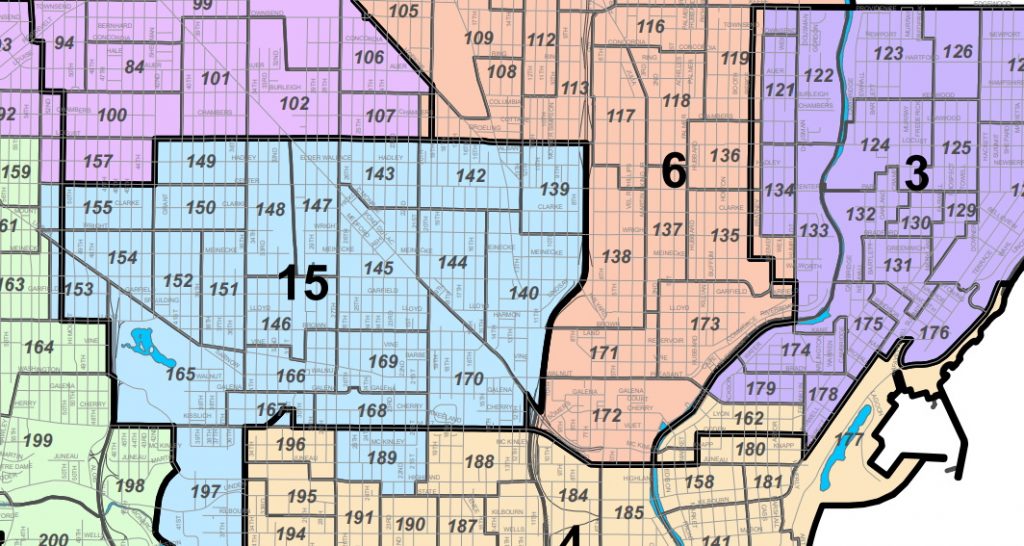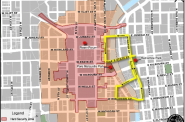Group Introduces Nine Options To Create Three Latino-Majority Council Districts
But none have majority Latino voting age populations today. Will Barrett veto?
The clock is running out, but Voces de la Frontera isn’t giving up the fight.
Voces, a Latino-focused immigrant and workers’ rights organization, previously called for Mayor Tom Barrett to veto the council’s map and adopt one targeted at creating a third majority Latino district within the decade. It renewed that call Thursday evening, sending Barrett nine options for district maps intended to create a third Latino majority council seat.
The Common Council adopted its final map on Nov. 23 on a 14-1 vote, concluding its portion of a “warp speed” process created by delays at the federal, state and county level. Only Alderwoman JoCasta Zamarripa voted against the final map. In an interview after the vote, she expressed concern with Latino representation and the lack of alternatives considered.
The city is now 39.3% Black, 32.3% white, 20.1% Hispanic and 5.6% Asian. When considering only the voting age population, the city is 38.6% white, 36.1% Black, 17.6% Hispanic and 5.1% Asian.
The resulting 15 districts maintain the balance of six Black majority districts, two Hispanic districts and five white districts of which two are being described as Hispanic “influence” districts. There is no legal definition for an “influence” district, but the council is informally defining it as a 25% voting bloc. Two districts have no racial or ethnic majority.
“Last year, Voces de la Frontera actively worked during a pandemic and under a hostile administration to encourage Latinxs to participate in the census so that new districts would reflect the importance of Milwaukee’s growing Latinx community for the next ten years,” said Voces executive director Christine Neumann-Ortiz in a statement. “The maps we are proposing clearly recognize the scale, movement and growth of the Latinx community in Milwaukee. We call upon Mayor Barrett to veto the map approved by the Common Council last week, which needlessly split the Latinx voter population into Aldermanic districts 11, 13, and 14 rather than attempting to combine the Latinx majority on the farther south side.”
Zamarripa, in an interview after her vote, and Ald. Scott Spiker, who represents the district Voces wishes to redraw into a Hispanic majority, both acknowledged the difficulty in creating a third Hispanic-majority district without diluting existing Hispanic-majority districts or drawing irregularly-shaped districts. Voces in its first suggested map produced two long, narrow southeast side districts instead of the more rounded shapes that currently exist.
But working with UW-Milwaukee professor and districting board game creator Matt Petering, Voces has expanded its one suggestion to nine. Each would include three districts with Hispanic majorities or near majorities, but the third district in each scenario would not be a voting age majority which the Voting Rights Act uses as the definition for a racial majority. The influence of the Hispanic vote under any scenario could be further diluted by current disparities in Milwaukee in turnout between Hispanic and white voters.
The new district map will go into effect for the 2024 spring elections for all 15 council seats. Any special election occurring before that time, under state law, would occur with new wards, but under the prior district lines. The election commission would need to accommodate or restrict voters in the new, redrawn wards so that those voting align with those eligible under the prior districts.
The council adopted a new ward map on Nov. 17 which will impact where and with whom residents vote beginning with the spring 2022 elections. Any new district map also needs to follow the lines set forth by the wards. Barrett signed the ward map into law.
The terms Latino, Latinx and Hispanic were used interchangeably in this piece to represent the comments of a speaker or the wording of a document.
Maps and Statistics
- Voces-Petering Map Options
- Voces Original Concept Map
- Adopted District Map – Detailed
- Adopted District Map – 11×17
- Adopted District Map Demographics
- Adopted 2021 City Ward Map
- 2012 Ward Map
- 2012 Common Council Districts
- 2000 to 2010 Population Change by Aldermanic District
- 2010 to 2020 Population Change by Aldermanic District
- 2020 Population Change by Wards
- 2020 Aldermanic District Demographics
More about the Milwaukee County redistricting process
- Op Ed: Muslim Community Needs Representation - Janan Najeeb - Jan 29th, 2022
- City Hall: Council Ends Redistricting With Anger, Tears - Jeramey Jannene - Jan 18th, 2022
- Statement from Milwaukee Mayor Cavalier Johnson - Mayor Cavalier Johnson - Jan 18th, 2022
- City Hall: Latino Leaders Could Sue Over Redistricting - Jeramey Jannene - Jan 14th, 2022
- Latinx Leaders Condemn Common Council’s Refusal to Draw New Districts Reflecting Dramatic Growth of Latinx Population; Demand Second Legal Opinion - Voces de la Frontera - Jan 14th, 2022
- Voces de la Frontera Statement on Redistricting Decision - Voces de la Frontera - Jan 11th, 2022
- Statement on redistricting decision - Ald. JoCasta Zamarripa - Jan 10th, 2022
- City Hall: Milwaukee Starts Over On Redistricting, Only To Adopt Same Map Again - Jeramey Jannene - Jan 10th, 2022
- Statement by Milwaukee Mayor Tom Barrett: - Mayor Tom Barrett - Dec 14th, 2021
- City Hall: Council Halts Redistricting After Latino Pushback - Jeramey Jannene - Dec 14th, 2021
Read more about Milwaukee County redistricting process here
Political Contributions Tracker
Displaying political contributions between people mentioned in this story. Learn more.
























